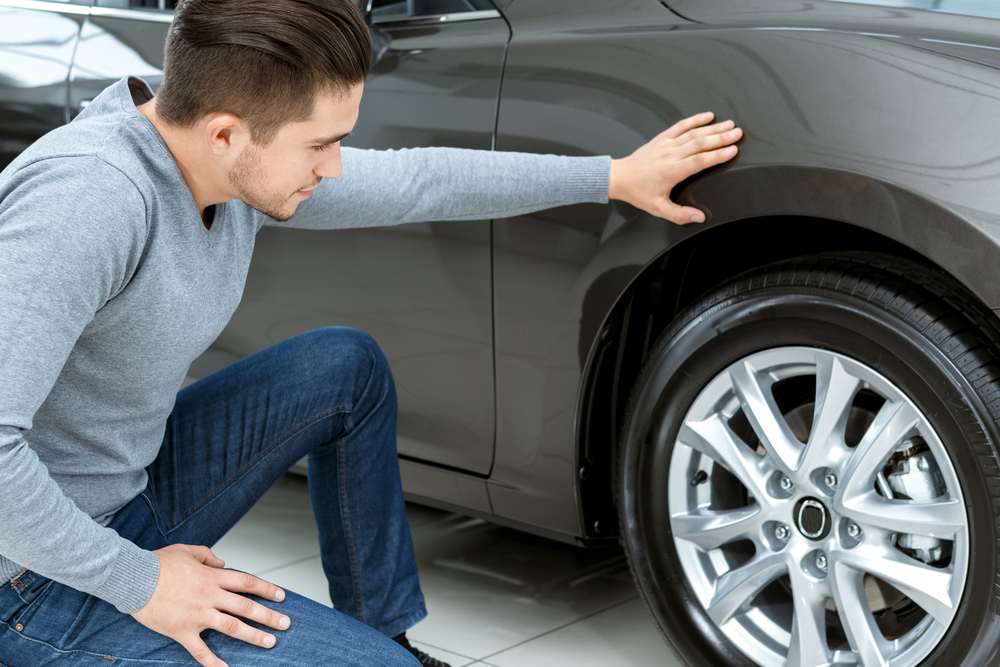Reliability? Safety? Price? Fuel Economy? Size? Performance? Handling? Comfort? Looks? Prestige? Quality?
Get a piece of paper and list each heading above in order of importance. Your list should look something like this:
- Safety
- Reliability
- Size
- Price
- Looks, Etc…
This will help you deal with this decision methodically in order to avoid impulse buying which car salespeople love, but which you may later regret.
Let’s take each selection criteria in turn and explore your options:
Reliability
A reliable car is one that keeps running well without requiring unscheduled repairs. The most reliable cars today seem to be coming out of Japanese companies, such as Toyota, Honda, Nissan, Subaru, & Mazda. Some people object to buying products from foreign companies, but if this is any consolation, many of these cars are manufactured in factories in the USA and they are just as reliable as the ones manufactured in Japan. Also, in today’s climate of mega mergers, you really don’t know which country your money will wind up. For instance, Ford Motor Company now owns Jaguar, Aston Martin, Volvo and a good portion of Mazda, while Chrysler and Mercedes have joined forces with Mercedes having the larger share of the combined company. If you must buy American, then you will be glad to know that the reliability and quality of American cars is steadily improving.

Remember, a reliable car will only stay that way as long as you properly maintain it and drive it sensibly. A neglected car, no matter how good it is,will eventually give you problems. See the section on “Caring for Your Car” for more information.

Safety
You can get the safety rating for the cars you are considering from The Insurance Institute for Highway Safety or the National Highway Traffic & Safety Administration (NHTSA). Every year they crash a number of cars and rate them for such things as severity of injury to the driver and the front seat passenger. Bear in mind that this test crashes each car into a fixed barrier. In the real world, many accidents involve two or more vehicles crashing into each other. In that situation, a large car with a poor rating may easily be safer than a smaller car with a good rating. More important than a car that crashes well, is a car that can avoid a crash altogether. But above all, remember that all of these test results were with test dummies that were wearing SEAT BELTS. Without seat belts,even a 15 mile per hour crash could be fatal!
One of the most important safety items on a car is the tires. A good set of tires can make a big difference in the way a car responds to emergency maneuvers. Tire quality also makes a big difference in the way a car handles. For instance, a touring tire has much more grip than an economy priced tire and will probably wear longer.
Look for a car with anti-lock brakes if possible. More and more new cars have them as standard equipment.
Above all, drive sensibly.
Price
Sure, you may find that bargain from a person who must sell by tomorrow, but in most cases someone he/she knows would have grabbed it before you ever heard about it if it really were a good deal. When a car is priced much less than its current book value, there is usually a reason why. It may have high mileage or problems that are not worth fixing.
Have your mechanic check out any “bargains” thoroughly before you proceed. Anything the mechanic finds will become points to negotiate if you still want the vehicle. If the car is old or has high mileage, you should also factor in something for unexpected problems.
If you are considering a NEW car, here are a few ways to save money.
- Buy a leftover new car from the previous year. Once the new model year car is in the showroom, any stock from the previous year is usually heavily discounted. The best time to buy is around January or February.
- Look for cars that have manufacturers rebates. Manufacturers must predict the sales volume for each model long before the first car is built so that they can outfit the factories and order the materials needed to produce them. When they overestimate the demand for a model, they often offer incentives in the form of rebates in order to clear the backlog. Some rebates can be thousands of dollars!
- Look to buying clubs to do the bargaining for you. Examples of clubs that have new car buying programs are AAA, Costco, Consumer Reports, etc. These clubs find dealerships that are willing to sell cars at fleet prices bypassing or limiting the salesperson’s commission. The first step is to contact the club to find out which dealers are participating and who to ask for. The next step is to write down the exact make and model of the car you want with all the options. But don’t expect to get a price quote on the phone. You must show up at the dealer and, in some cases, be prepared for a cool reception. You can get a good bargain this way but don’t expect the same level of friendliness that you get when you just walk in off the street. Sometimes the less friendly they are, the more you know you’re getting a good deal.

Fuel Economy
Gas mileage figures are listed on the window stickers of all new cars. Generally, the smaller, lighter, more aerodynamic, later model cars get the best gas mileage. If you are looking at a car because it gets great mileage even though you would prefer another model, try this little experiment. Figure how many miles you drive per year. Divide that figure by the miles per gallon, then multiply the result (gallons per year) by the price you pay per gallon. Do this for each car you are considering.
e.g.: You drive 10,000 miles per year. Car A averages 20 MPG, Car B gets 23 MPG. Gas costs $1.25 per gallon.
Car A will cost $625.00 per year for gasoline while Car B will cost $543.48 per year.
Difference $81.52 per year. Compare that amount to the price of the car itself.
Is the difference you spend per year on gas worth the sacrifice of driving a smaller car than you really want?
On the other hand, you might want to consider the impact that a large vehicle that burns more gas has on the environment. There is considerable controversy on whether driving thirsty vehicles affects national security by sending more money to countries that threaten us, or cause increased health risks. These are questions best left to your own sensibilities, or a more politically oriented website then this one is. But it is something to think about.
Performance
What is your definition of performance? Is it top speed? 0 to 60 acceleration? Powerful highway passing ability? If you are under 25 and are looking for the fastest thing on the road, there are a couple of facts you should know.
- If there are 5 cars speeding and the trooper can only pursue one, the choice will be the flashy performance car with the young driver.
- According to the NHTSA, on a per population basis, drivers under the age of 25 had the highest rate of involvement in fatal crashes among all age groups.
- The faster the car, the greater the temptation to show it off and to join the above statistics.
Now that that’s off my chest… the average modern sedan will accelerate from 0 to 60 miles per hour in about 10 seconds and is adequate for most driving situations. Some more expensive cars (or cars with optional engines) can approach 8 seconds to 60 and feel quite powerful pressing you firmly into the seat back. Faster than that and you will attract unwelcome attention.
If you are looking for a powerful engine, make sure that it’s balanced with good brakes, a sports suspension and performance tires. Rear wheel drive high performance cars can be a handful in wet weather or snow with a strong tendency to spin out.

Handling
Good handling is a very subjective quality. Some people think good handling is when you can drive with one finger and just point the car in the direction you want to go, while others like heavy steering and a strong “feel of the road”. A lot of effort has been expended in creating the perfect feel. The 1996 Lincoln Continental went so far as to allow you to adjust the ride and the steering feel from a computer panel on the dashboard!
To me, good handling is when the car feels like an extension of myself, anticipating my moves. The best handling car I’ve ever experienced is the Honda Prelude. Modern sedans have come a long way since the days of the marshmallow ride and now have excellent handling and feel of the road while still riding very comfortably. If you are concerned about handling, make sure you drive the car on an extended road test, or if possible, rent one before you buy it.
Comfort
Comfort is also very subjective and most people know what they consider comfortable. Some people like pillow soft seats similar to their favorite armchair while others like a firm supportive seat that has many adjustments. But there are other things to consider that are even more important.
- Can you adjust the seat and steering wheel to a comfortable position where you can reach the pedals and see over the steering wheel?
- Do you have a clear view of the road?
- Can you see the instrument panel clearly without reading glasses?
- Does the seat belt fit properly without binding around your neck?
- Are you at least 12 inches away from the steering wheel? (closer than that and you could be hurt by the airbag if it is activated)
- With your seat adjusted for you, is there room for the passenger who might sit behind you?
Looks
Do you want a car that stands out in a crowd or one that blends in? Looks are obviously a matter of taste. I personally like the looks of most of the late model Chrysler products.
Color is also a matter of personal preference; however, there area few points to consider:
- If two cars are speeding along the highway, one silver blue and the other bright red, the red car will get the attention first (whether good or bad).
- Gray cars are harder to see in adverse weather conditions.
- White cars stay cooler in the hot sun; while dark colors tend to absorb heat
- White cars, like white clothing, are harder to keep looking clean.

Prestige
Some people use a car as a way to show that they have “arrived”. A car canal so label you “sensible,” “conservative,” “snobbish,””cheap,” “showoff”. Well, you get the idea.
Cars with high prestige value are Mercedes Benz, BMW and Lexus
Size
Size can be a consideration if you live in the city and must park on the street.
Make sure there is enough room for your needs. Sit in the backseat after you adjust the front seat for the tallest driver. Check the trunk. Watch the hinges as the trunk closes. Some hinges invade the trunk space and restrict what you can place in their path.
If you need room, consider a minivan. They provide the most usable space for their size.
Quality
How is the Fit and Finish on the car you are looking at. Check the seams between doors and body panels. Are they all even? To see the best fit and finish check out a Lexus or Mercedes or even a Toyota Camry. Also, check the knobs and switches on the dash. Feel the way they work. Are they flimsy or do they feel expensive. Slam some doors. You’ll start seeing a pattern emerging on certain cars. If the things you see and feel on the surface look good, then chances are, the quality will also be good beneath the surface.

Any information provided on this Website is for informational purposes only and is not intended to replace consultation with a professional mechanic. The accuracy and timeliness of the information may change from the time of publication.

















